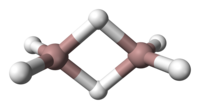Digallane
 |
|
| Names | |
|---|---|
|
IUPAC name
digallane(6)
|
|
| Other names
Di-μ-hydrido-tetrahydridodigallium
Gallane dimer |
|
| Identifiers | |
| Properties | |
| Ga2H6 | |
| Molar mass | 145.494 g/mol |
|
Except where otherwise noted, data are given for materials in their standard state (at 25 °C [77 °F], 100 kPa).
|
|
|
|
|
| Infobox references | |
Digallane (systematically named digallane(6) and di-μ-hydrido-bis(dihydridogallium)) is an inorganic compound with the chemical formula GaH
2(H)
2GaH
2 (also written [{GaH
2(μ-H)}
2] or [Ga
2H
6]). It is the dimer of the monomeric compound gallane. The eventual preparation of the pure compound, reported in 1989, was hailed as a "tour de force." Digallane had been reported as early as 1941 by Wiberg; however, this claim could not be verified by later work by Greenwood and others.
A two-stage approach proved to be the key to successful synthesis of pure digallane. Firstly the dimeric monochlorogallane, (H2GaCl)2 (containing bridging chlorine atoms and thus formulated as (H2Ga(μ-Cl))2) was prepared via the hydrogenation of gallium trichloride, GaCl3, with Me3SiH. This step was followed by a further reduction with LiGaH4, solvent free, at −23 °C, to produce digallane, Ga2H6 in low yield.
Digallane is volatile and condenses at −50 °C into a white solid.
Electron diffraction measurements of the vapour at 255 K established that digallane is structurally similar to diborane with 2 bridging hydrogen atoms (so-called three-center two-electron bonds). The terminal Ga—H bond length is 152 pm, the Ga—H bridging is 171 pm and the Ga—H—Ga angle is 98°. The Ga—Ga distance is 258 pm. The 1H NMR spectrum of a solution of digallane in toluene shows two peaks attributable to terminal and bridging hydrogen atoms.
...
Wikipedia
